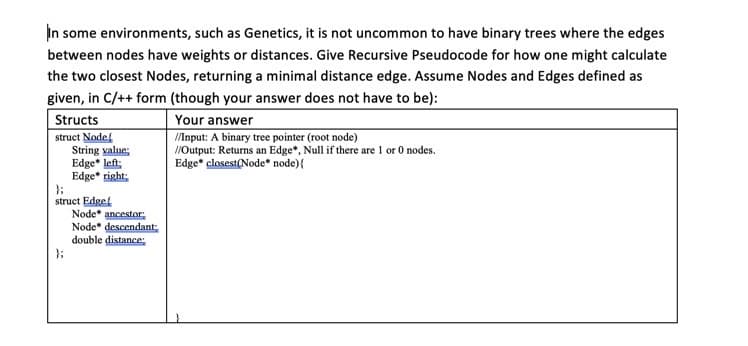In some environments, such as Genetics, it is not uncommon to have binary trees where the edges between nodes have weights or distances. Give Recursive Pseudocode for how one might calculate the two closest Nodes, returning a minimal distance edge. Assume Nodes and Edges defined as given, in C/++ form (though your answer does not have to be): Structs Your answer struct Nodel String value; Edge* left: Edge* right: /Input: A binary tree pointer (root node) /Output: Returns an Edge", Null if there are l or 0 nodes. Edge* closest(Node* node){ struct Edgel Node ancestor: Node" descendant. double distance:
In some environments, such as Genetics, it is not uncommon to have binary trees where the edges between nodes have weights or distances. Give Recursive Pseudocode for how one might calculate the two closest Nodes, returning a minimal distance edge. Assume Nodes and Edges defined as given, in C/++ form (though your answer does not have to be): Structs Your answer struct Nodel String value; Edge* left: Edge* right: /Input: A binary tree pointer (root node) /Output: Returns an Edge", Null if there are l or 0 nodes. Edge* closest(Node* node){ struct Edgel Node ancestor: Node" descendant. double distance:
Computer Networking: A Top-Down Approach (7th Edition)
7th Edition
ISBN:9780133594140
Author:James Kurose, Keith Ross
Publisher:James Kurose, Keith Ross
Chapter1: Computer Networks And The Internet
Section: Chapter Questions
Problem R1RQ: What is the difference between a host and an end system? List several different types of end...
Related questions
Question

Transcribed Image Text:In some environments, such as Genetics, it is not uncommon to have binary trees where the edges
between nodes have weights or distances. Give Recursive Pseudocode for how one might calculate
the two closest Nodes, returning a minimal distance edge. Assume Nodes and Edges defined as
given, in C/++ form (though your answer does not have to be):
Structs
struct Node
String value;
Edge* left:
Edge* right:
Your answer
/Input: A binary tree pointer (root node)
//Output: Returns an Edge*, Null if there are 1 or 0 nodes.
Edge" closest(Node* node){
struct Edgef
Node* ancestor:
Node* descendant
double distance;
Expert Solution
This question has been solved!
Explore an expertly crafted, step-by-step solution for a thorough understanding of key concepts.
Step by step
Solved in 2 steps

Recommended textbooks for you

Computer Networking: A Top-Down Approach (7th Edi…
Computer Engineering
ISBN:
9780133594140
Author:
James Kurose, Keith Ross
Publisher:
PEARSON

Computer Organization and Design MIPS Edition, Fi…
Computer Engineering
ISBN:
9780124077263
Author:
David A. Patterson, John L. Hennessy
Publisher:
Elsevier Science

Network+ Guide to Networks (MindTap Course List)
Computer Engineering
ISBN:
9781337569330
Author:
Jill West, Tamara Dean, Jean Andrews
Publisher:
Cengage Learning

Computer Networking: A Top-Down Approach (7th Edi…
Computer Engineering
ISBN:
9780133594140
Author:
James Kurose, Keith Ross
Publisher:
PEARSON

Computer Organization and Design MIPS Edition, Fi…
Computer Engineering
ISBN:
9780124077263
Author:
David A. Patterson, John L. Hennessy
Publisher:
Elsevier Science

Network+ Guide to Networks (MindTap Course List)
Computer Engineering
ISBN:
9781337569330
Author:
Jill West, Tamara Dean, Jean Andrews
Publisher:
Cengage Learning

Concepts of Database Management
Computer Engineering
ISBN:
9781337093422
Author:
Joy L. Starks, Philip J. Pratt, Mary Z. Last
Publisher:
Cengage Learning

Prelude to Programming
Computer Engineering
ISBN:
9780133750423
Author:
VENIT, Stewart
Publisher:
Pearson Education

Sc Business Data Communications and Networking, T…
Computer Engineering
ISBN:
9781119368830
Author:
FITZGERALD
Publisher:
WILEY